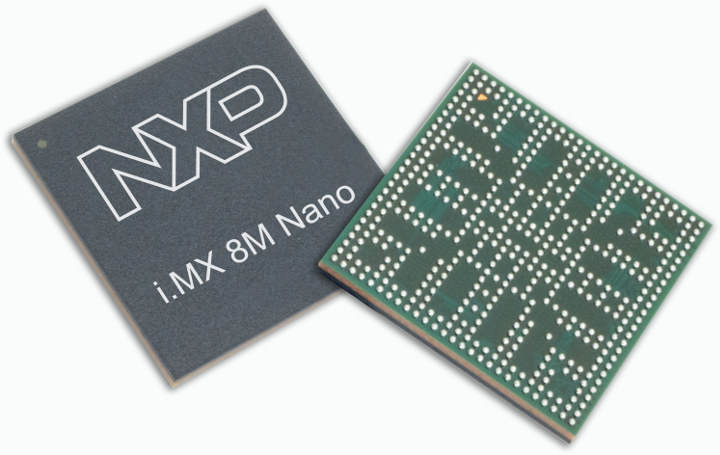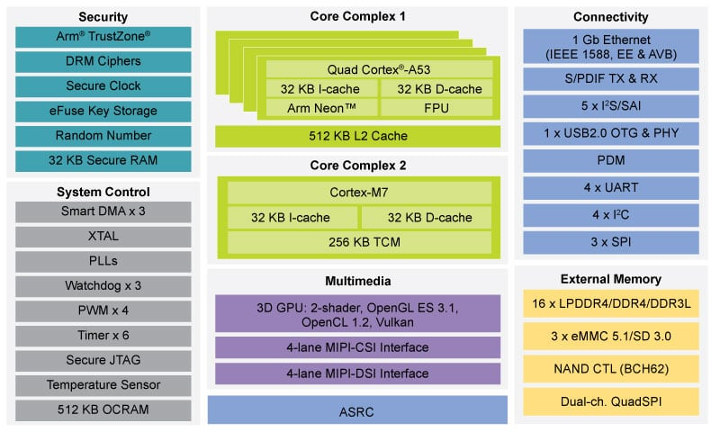NXP introduced their first 14nm i.MX processor at Embedded World 2018 last year with i.MX 8 Mini processor equipped with up to four Cortex A53 cores clocked at 2.0 GHz and one real-time Cortex-M4 cores clocked at 400+ MHz, and optional 1080p video output and decoding/encoding.
The company has now added another 14nm member to their i.MX 8M family with NXP i.MX 8M Nano family also featuring four Cortex-A53 cores at up to 1.5 GHz, but replacing the Cortex-M4 by a more powerful Cortex-M7 core clocked at up to 600 MHz. The processor is also power-optimized for less than 2W total dynamic power (TDP) and sub-watt in many IoT edge applications.
 NXP i.MX 8M Nano key features and specifications:
NXP i.MX 8M Nano key features and specifications:
-
- Application cores – One to four Arm Cortex-A53 cores up to 1.5 GHz per core; 32KB L1-I Cache/ 32 KB L1-D Cache; 512 KB L2 Cache
- Real-time core – Arm Cortex-M7 at speeds of up to 600 MHz; 16 KB L1-I Cache/ 16 KB L2-D Cache
- Memory I/F – 16-bit DDR3L, DDR4, LPDDR4
- Storage I/F – 8-bit managed NAND with 62-bit ECC, 16/32-bit NOR, QuadSPI
- GPU – 2D GPU, 3D GPU (2x shader, OpenGL ES 2.0/3.0/3.1, OpenCL 1.2, Vulkan)
- Display – 1x 4-lane MIPI DSI with PHY
- Audio – 5x SAI (10Tx + 10Rx external I2S lanes), 8-ch PDM input, S/PDIF Tx & Rx
- Camera – 1x 4-lane MIPI CSI with PHY
- USB – 1x USB 2.0 OTG controller with integrated PHY
- Networking – 1x Gigabit Ethernet (MAC) with AVB and IEEE 1588, Energy Efficient Ethernet (EEE) for low power
- Other I/Os – 4x UART, 4x I2C, 3x SPI, etc..
- Package – FCBGA, 14×14 0.5mm pitch
- Temperature Range – Consumer: 0°C to 95°C Tj; industrial: -40°C to 105°C Tj
- Process – 14nm LPC FinFET

Note there’s no video decoder or encoder, but it does have one new audio feature with an hardware accelerator for asynchronous sample rate conversion (ASRC) supporting up to 32 channels of high-quality audio streaming.
The company provides support for Linux & Android on the Cortex-A53 cores, and FreeRTOS on the Cortex-M7 core, NXP i.MX 8M Nano is software compatible with other NXP i.MX 8M processor, and NXP and Microsoft are working to bring Azure IoT Edge to i.MX 8M applications processors across Linux and Windows 10 IoT core OS.
The new i.MX 8M are also pin-to-pin compatible with NXP i.MX 8M mini family so they could be used as drop in replacement is current designs. However, NXP still designed a Nano development board (EVK) comprised of a compute module and a base board that brings out the broad connectivity. The compute module is designed to support LPDDR4, DDR4, DDR3L RAM, and also includes a PMIC, eMMC flash, and a soldered-down Wi-Fi/BT module.
NXP i.MX 8M Nano will start sampling in Q2 2019, with general sampling and mass production scheduled for Q4 2019. You’ll find some more details in the product page.

Jean-Luc started CNX Software in 2010 as a part-time endeavor, before quitting his job as a software engineering manager, and starting to write daily news, and reviews full time later in 2011.
Support CNX Software! Donate via cryptocurrencies, become a Patron on Patreon, or purchase goods on Amazon or Aliexpress




